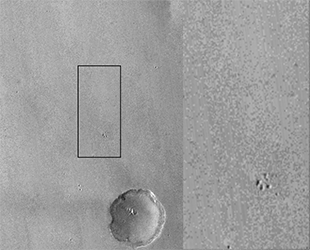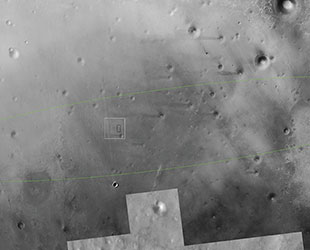October 21, 2016 — Europe's Schiaparelli lander not only slammed into Mars at "a considerable speed," but it may have exploded on impact, a new photo from a U.S. orbiter has revealed.
The European Space Agency (ESA) on Friday (Oct. 21) released the first image of what are likely the remains of its entry, descent and landing demonstrator, which attempted to touch down on the Red Planet Wednesday. The photos were taken by a low-resolution context camera on NASA's Mars Reconnaissance Orbiter (MRO).
"The image released today ... shows two new features on the surface when compared to an image from the same camera taken in May [of] this year," ESA officials wrote in a statement posted on its website.
One of the features is bright and, according to ESA, can be associated with the 39-foot (12-m) diameter parachute that was used to slow Schiaparelli's decent after it entered the Martian atmosphere. The parachute and its associated back shell were released from the lander prior to it firing its thrusters, which was meant to further slow Schiaparelli to a standstill just above the surface.

Pair of before-and-after images taken by the Context Camera (CTX) on NASA's Mars Reconnaissance Orbiter on May 29, 2016 and Oct. 20, 2016 show two new features appearing following the arrival of the Schiaparelli lander on Oct. 19. (NASA/JPL-Caltech/MSSS) |
Instead, it is believed the lander's nine retrorockets shut off earlier than anticipated, resulting in Schiaparelli free falling 1.2 to 2.5 miles (2 to 4 km), ultimately hitting the surface at a speed in excess of 186 mph (300 km/h).
Hence, the other feature now spotted on Mars — a "fuzzy dark patch" approximately 50 by 130 feet (15 by 40 m) in size and about 0.6 miles (1 km) north of the parachute.
"It is also possible that the lander exploded on impact, as its thruster propellant tanks were likely still full," ESA said.
A closer look at these features will be taken next week with HiRISE, MRO's highest-resolution camera. These images may also reveal the impact location of Schiaparelli's front heat shield, which was jettisoned at a higher altitude.
Telemetry transmitted by Schiaparelli as it descended was recorded by the lander's ExoMars companion spacecraft, ESA's Trace Gas Orbiter (TGO), which began circling the Red Planet on Wednesday. The data stream cut off about 50 seconds before Schiaparelli was to touch down.

Schiaparelli's crash site within the predicted landing ellipse in a mosaic of images from NASA's Mars Reconnaissance Orbiter and 2001 Mars Odyssey orbiter. (NASA/JPL-Caltech/MSSS, ASU) |
"A substantial amount of extremely valuable Schiaparelli engineering data were relayed back to the TGO during the descent and is being analyzed by engineers," stated ESA.
Though it had been equipped with a small meteorological station, Schiaparelli was primarily designed to demonstrate the entry, descent and landing technologies needed for the ExoMars 2020 mission, which will place a European rover and a Russian platform on the planet's surface.
The imaged remains of the Schiaparelli probe are located at 353.79 degrees east longitude by 2.07 degrees south latitude in the Meridiani Planum region of Mars. The dark mark's location shows Schiaparelli impacted approximately 3.4 miles (5.4 km) west of its intended touch down point — well within the mission's nominal 62 by 9 mile (100 by 15 km) target ellipse — near where NASA's Opportunity rover landed in 2004.
Since Schiaparelli's descent was recorded from different locations, ESA states it is confident its engineering teams will be able to reconstruct the chain of events "with great accuracy," to determine the "exact mode of anomaly" that caused the lander to crash on Mars.
